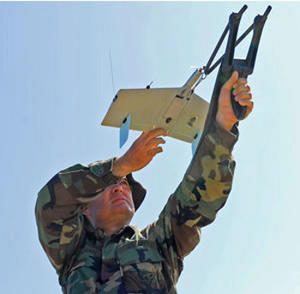Law enforcement technologyDomestic use of drones make privacy advocates anxious
The age of Micro Air Vehicle (MAV) UAV is coming; for now, use of these types of drones for high-risk law enforcement purposes is rare, although the Federal Aviation Administration (FAA) plans to implement new rules that would allow the routine flying of these drones across the United States by 2013; equipped with high-resolution, infrared and thermal-imaging cameras, these drones could provide police with the accurate monitoring of all types of civilian areas and topographies; privacy advocates worry

Launching the WASP micro-UAV // Source: defense-update.com
AeroVironment’s (AV) Wasp is a Micro Air Vehicle (MAV) that provided Texas law enforcement officers and SWAT members with the confidence to raid and successfully detain a highly armed and dangerous suspect.
The aerial sweep of the suspect’s property was the first ever accomplished by a drone in the state which did not involve border patrol. The drone’s use foreshadows what some contend is an invasion of privacy through the misuse of technology.
Reaching heights of up to 400 feet, these small, portable, and rugged unmanned aerial platforms were designed for front-line day/night reconnaissance and surveillance by AV and the Defense Advanced Research Projects Agency (DARPA). For now, use of these types of drones for high-risk law enforcement purposes is rare, although the Federal Aviation Administration (FAA) plans to implement new rules that would allow the routine flying of these drones across the United States by 2013. Equipped with high-resolution, infrared and thermal-imaging cameras, these drones could provide police with the accurate monitoring of all types of civilian areas and topographies.
According to legal experts, police will still have to attain warrants prior to spying on private residences of interest. A report by the Washington Post details how as of 1 December 2010, the FAA allowed more than 270 authorizations for the use of varying types of drones, of which 35 percent were held by the Defense Department, 11 percent by NASA, and 5 percent by DHS. Since the aforementioned search and seizure of the suspect in Austin, the department of public safety in Texas has run six operations using drones to conduct surveillance of drug and human traffickers at the southern border.
The drone’s effectiveness, cost, and simplicity are helping to boost the allure of the technology; interest by the United Kingdom might lead to aerial surveillance for the 2012 Olympics in London. An entire system, along with the ground operating computer amounts to less than $50,000 — compared to the approximate cost of $1 million for a helicopter. This disparity in cost is the reason why fewer than 300 of the approximately 19,000 law enforcement agencies in the United States have an aerial capability.
Before opening up the airspace to drone technology, the FAA will be addressing whether unmanned aircraft will be able to “handle communication, command, and control,” as well as how their ability to “sense and avoid” other aircraft, since the drones typically operate in a battlefield environment.
